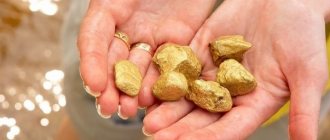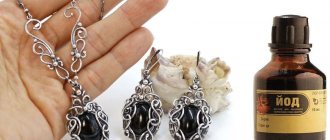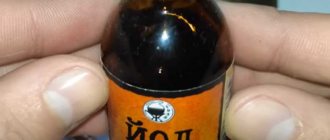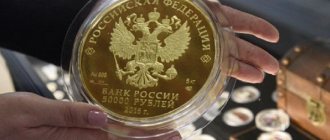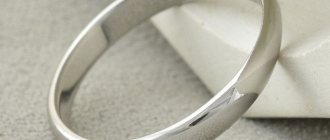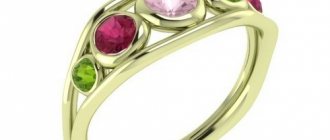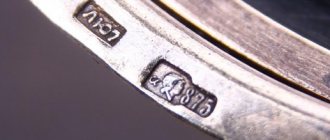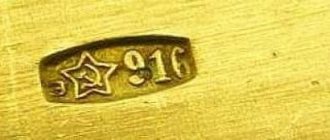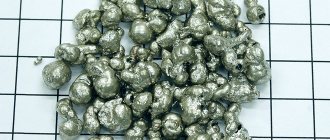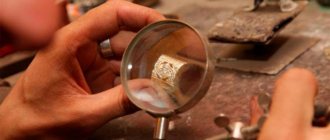Refining of precious metals is a special purification procedure. Precious metals can be subjected to it in the following form:
- technical scrap containing gold;
- gold in concentrate form;
- scrap jewelry;
- residues after electrical cleaning procedures;
- so-called “silver foam”;
- concentrates from deposits, etc.
The procedure for obtaining refined metals consists of preparation stages, which necessarily includes the process of grinding, roasting and fusion with zinc.
Spot gold - what is it, definition and characteristics. Origin of the word "shlikh"
Scatter gold is medium or very small grains, scattering, large nuggets remaining in the washing trays as part of other elements after washing out the lightest particles. The noun “slich” itself is of Germanic origin and means “concentrate, sediment, precipitation.”
This type of precious metal contains a huge amount of impurities, but after all the necessary cleaning procedures it corresponds to 999 samples.
Grains of gold
All gold that has just been washed off the banks of rivers and has not undergone melting and refining is called schlich. The composition of the concentrate contains grains of minerals that are resistant to physical weathering.
Thus, gold-bearing raw materials are the simplest description of concentrate. It includes various rocks, stones, dust, sediment, that is, everything from which solar metal is obtained.
Home refining process
The method for extracting refined gold is quite simple, but requires certain knowledge and equipment. And one more thing, friends: if you do not have access to huge reserves of decommissioned electrical equipment containing precious metals, then take this material as a scientific experiment. Do not try to make money on it - you will lose more with a guarantee.
Please note: chemicals must be handled with great care and chemicals must be disposed of afterwards.
Necessary raw materials, equipment and reagents
So, we collected gold-bearing junk that had been collecting dust at home and in the garage for years. Let's start with security.
You will need:
- latex gloves;
- protective glasses;
- gas mask or respirator (if you work indoors);
- a room equipped with an exhaust hood.
Now the equipment:
- one glass container;
- a pair of measuring cups;
- scissors;
- coffee filter.
And finally, chemicals. A few grams of hydrochloric acid will be required. It is sold in specialized stores. Or you can buy household chemicals that contain it, such as toilet cleaner. We also need hydrogen peroxide 3% (sold in pharmacies) and water.
Preparation
At this stage, you need to remove all gold-containing parts from the boards. Pull out anything yellow or what appears to be yellow. If necessary, cut the boards with scissors. The main thing is that they are completely immersed in the container with the solution. Next, rinse all parts with water and dry thoroughly.
Put on a respirator and gloves - let's move on to the next stage.
Affination process
It is necessary to mix the reagents: hydrogen peroxide with acid (toilet bowl cleaner) in equal parts and place the circuit boards and parts into the solution. This moment is the most dangerous: as a result of the reaction, a small amount of chlorine gas is released.
The resulting solution is called etching solution. It dissolves the nickel, freeing (refining) the gold foil. Then all that remains is to wait. The process may take up to 7 days. The flaked gold will settle at the bottom of the container.
You can separate gold from the solution using a coffee filter. Be careful not to tear the paper bag. If necessary, the remaining gold foil is scraped off from used circuit boards. That's all, actually.
If you think that you have collected enough gold, you can start smelting:
- place the gold foil in the crucible (along with the bag);
- sprinkle with borax;
- heat with a gas burner.
Continue the process until an ingot is formed.
Stages of the schlich method of gold mining
The spot method is rightfully considered the oldest method of searching for precious metals. In terms of popularity, it is not inferior to the dredge method. During the time when the gold rush was on the minds of people, the largest deposits of placer gold were discovered by washing concentrates of various rocks using ordinary washing pans, shovels, perseverance and, of course, luck.
The loose rock is processed either to a gray concentrate containing relatively light minerals, or to black, which is considered the final stage of washing. The final finishing of the material takes place in special trays.
There are several different versions of such trays - Korean, Siberian, Kharitonov and others. Most often, plastic and Korean trays are used for work. The raw material from which it is made affects the level of washing and extraction of concentrate. Geologists take this factor into account when analyzing the results of concentrate searches.
What is refining and why is it needed?
Refining is the process of purifying a metal from impurities or isolating it from a rock. To begin with, gold is in most cases mined in the form of ore, and the content of the precious metal in the rock can vary significantly.
The ore is then sent to a processing plant, where it is purified and refined metal is produced. In our case, refined gold of the highest standard - 999.9.
Precious metal scrap, consisting of jewelry and other items, contains various impurities. Therefore, it also needs to be refined.
Legal aspects
This should never be forgotten. Because ignorance of the laws... The point is this: all gold extracted from the depths or refined, and other precious metals, are subject to delivery to the state. Evasion from this rule may entail liability under Article 192 of the Criminal Code of the Russian Federation.
In 2015, a law was signed that somewhat softened the situation. Thus, individual entrepreneurs and organizations received the right to independently refine their previously produced products, returning the material to trade.
On the other hand, sanctions against the sale of refined gold were supplemented by Article 15.45 of the Code of Administrative Offenses of the Russian Federation dated December 27, 2019. Here are the fines for the illegal extraction, purchase, sale, storage and movement of precious metals, with mandatory confiscation. In general, be careful if you are going to get refined gold.
What precious metals can be refined
The most in demand precious metals are platinum, gold, silver, palladium and rhodium. This is understandable, because the cost of them is consistently high. However, any non-ferrous metals have their own price, and processing enterprises will gladly buy them to obtain a refined product.
Where can the procedure be performed?
There are several licensed processing plants in Russia. They are strictly controlled by the state.
It is to them, in theory, that precious metals should flock from all sorts of sources:
- Prioksky Non-Ferrous Metals Plant, Kasimov. Produces gold of the highest standard, replenishing the gold reserves of the Russian Federation.
- Novosibirsk Refinery. Processes gold for Gokhran using a mixture of nitric and hydrochloric acid.
- Krasnoyarsk Non-Ferrous Metals Plant. The only manufacturer of all types of precious metals.
- Shchelkovo secondary precious metals plant. Refines scrap containing silver and gold.
- Ekaterinburg non-ferrous metals processing plant. Refines platinum group metals, gold, extracts precious metals from recycled materials.
- JSC "Uralelectromed", Verkhnyaya Pyshma. The plant's raw materials are copper concentrates, which include the gold group.
- Kolyma Refinery. Focused on processing local ore and recyclable materials containing gold and other precious metals.
- Kyshtym copper electrolyte plant. His line of business is the extraction of precious metals from low-grade scrap containing gold and silver, without platinum group metals.
Therefore, a person does not have many options: to refine the metal handicraft, at home, not forgetting about the laws, negotiate with a jeweler (which is very doubtful), sell your gold to buyers.
Instead, you can buy refined gold bars or gold of the required standard.
Gold purification technologies (refining)
Extracting gold from concentrate is a painstaking process. It is called refining, and it is based on differences in the chemical and physical characteristics of metals.
When mining on an industrial scale, the precious metal is delivered to refineries in metal containers.
There are three refining technologies:
Electrolytic method
This technique is most beneficial for large production volumes and is most often used in large refineries. The method involves deposition of precious metals on an electrode and consists of two stages:
- Dissolving one of the electrodes in aqua regia or hydrochloric acid. Dissolution is accompanied by the application of current.
- Deposition of metals on the second electrode. Deposition is observed in layers, the first of which is the most precious metal.
For cleaning by electrolysis, it is required that the crude precious metal has a purity of at least 950. Then the procedure will allow you to obtain gold of maximum purity.
Refining - electrolytic method
Wet method
Recycling is accomplished by incorporating other metals to activate the process. The method may vary depending on the elements used.
How profitable are investments in refined precious metals?
Refined precious metals, as an investment object, differ from ordinary precious metals in their exceptional “purity” (fineness). Therefore, investments in such “pure” metal usually involve the purchase of bullion or the opening of compulsory medical insurance (unallocated metal accounts).
There are associated costs associated with using an investment vehicle such as bullion. Each sales transaction requires the buyer to pay VAT. And storing bullion precious metal in a bank is a paid service. Despite this, such an investment in a refined precious metal, be it palladium, silver, platinum or gold, can be very attractive and profitable.
Refined or “pure” metal is always a profitable investment instrument. But here it is important to correctly understand the timing of investment placement, which can be at least 2-3 years. Only such a time period allows us to understand the price dynamics of the market and choose the optimal moment to sell assets. You also need to know that finding a buyer for bullion to conclude a mutually beneficial deal usually takes a lot of time.
A simpler method of investing in “pure” precious metals is to open a compulsory medical insurance. It allows you to become the owner of bullion without having them in your hands, and without incurring the costs of transportation, storage, etc. Profit from compulsory medical insurance depends on the difference between the purchase price and the sale price of the precious metal.
Refined precious metals have an unconditional value that does not decrease over time. They are not subject to inflation and external economic influences. Therefore, the prospects, profitability and security of investing in them are indisputable.
Metal sample after cleaning and its value on the stock market
After cleaning, the precious metal will correspond to the highest standard. Such a sample is designated by the number 999 in the metric system or by the sign “24K” in the karat system. According to the standard established by GOST, it contains 99.9% pure gold per gram of total mass.
The price for such metal is set by the Central Bank of the Russian Federation based on quotes from the London Stock Exchange.
Today, the current cost of the highest standard of gold varies on the stock market around 3800-4000 rubles per gram.
Choose Gold bars: find out availability, prices and buy online
The largest exporters from Russia, Kazakhstan, Uzbekistan, Belarus, official contacts of companies. Through our website, you can send a request to all representatives at once if you want to buy Gold bars.
